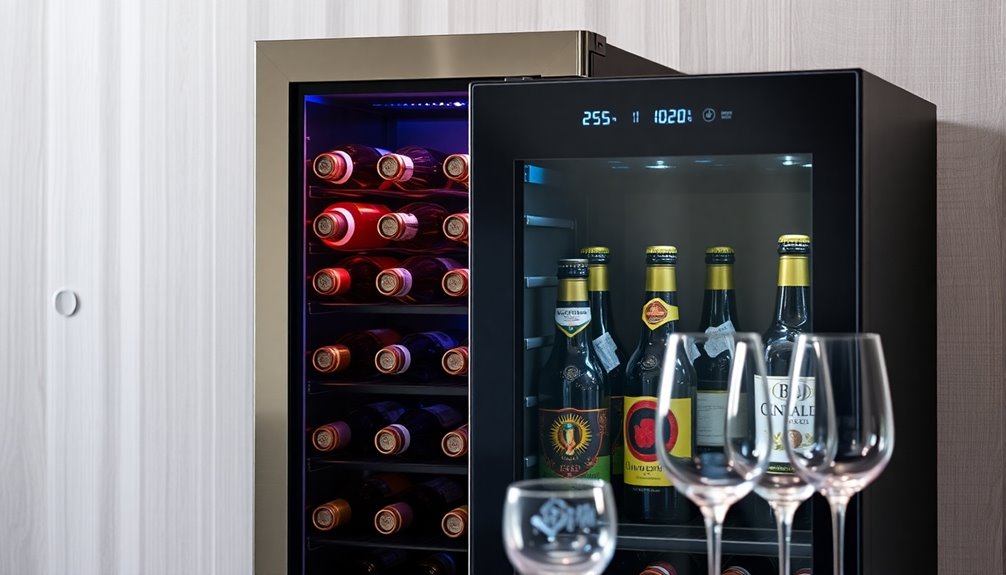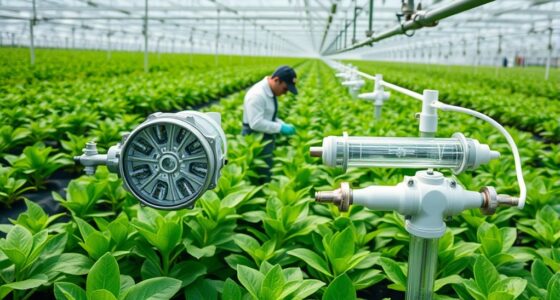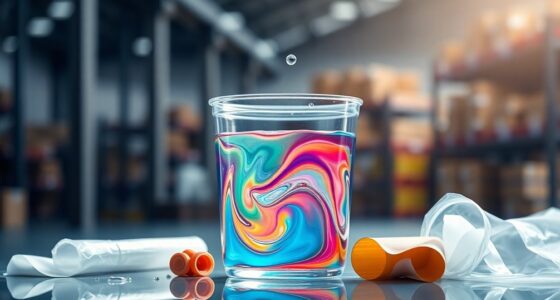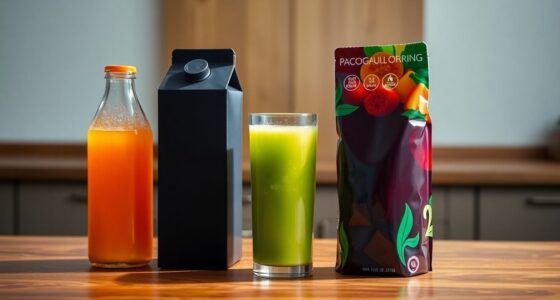To store beverages like wine most effectively, keep them around 55°F (13°C) for ideal flavor. Avoid regular refrigerators, as they're too cold, and steer clear of areas with fluctuating temperatures. Protect your bottles from sunlight and maintain humidity levels around 70%. Store your bottles sideways to keep the cork moist, and minimize vibrations to preserve quality. There's more to learn about enhancing your beverage storage experience, so stick around for deeper insights!
Key Takeaways
- Maintain a consistent temperature around 55°F (13°C) to preserve the flavors and aromas of beverages, especially wine.
- Avoid storing beverages above 70°F (21°C) to prevent "cooking" and flavor flattening.
- Keep humidity levels around 70% to prevent cork drying and spoilage while avoiding mold growth.
- Store bottles sideways to keep the cork moist and maintain its integrity for long-term storage.
- Regularly monitor temperature and humidity to ensure optimal conditions for your beverages.
The Ideal Storage Temperature for Wine
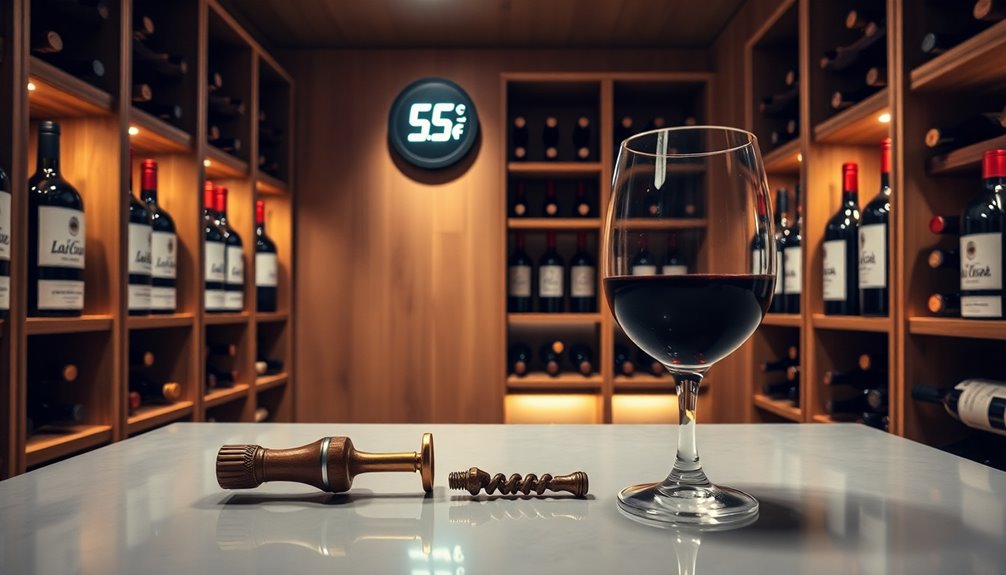
When you're storing wine, the ideal temperature hovers around 55°F (13°C) to keep its flavors and aromas intact. A consistent temperature is essential; fluctuations can lead to cork displacement and spoilage.
If you store your wine above 70°F (21°C), you risk "cooking" it, which flattens aromas and flavors. To guarantee quality and safety, aim for dark storage conditions, as UV rays can degrade wine over time.
Additionally, maintaining a humidity level of around 70% prevents corks from drying out and allows air to spoil the wine. By controlling these factors, you create the perfect environment for your bottles, preserving their character until you're ready to enjoy them. HEPA filtration is essential for ensuring that the air in your storage space remains clean and free from pollutants that could affect the wine's quality.
Avoid Long Term Storage in a Regular Refrigerator
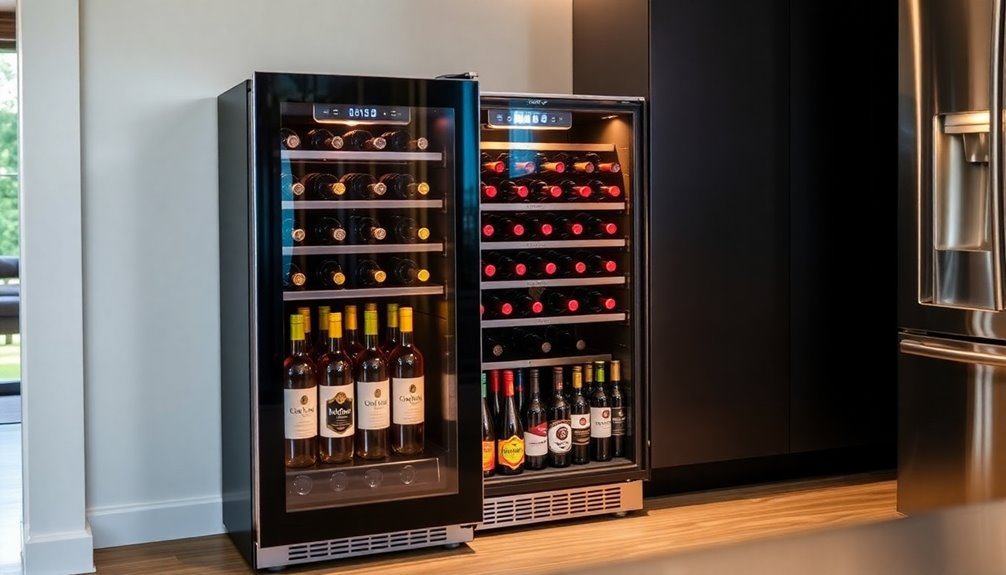
You shouldn't store wine long-term in a regular refrigerator.
The low temperatures can ruin its flavor and aroma, while the lack of humidity may dry out the cork, letting air spoil your wine.
Plus, freezing temperatures can push corks out, creating a mess and ruining your bottles.
Temperature Too Low
Although it might seem convenient to store wine in a regular refrigerator, doing so for the long term can seriously compromise its quality.
Regular fridges typically operate below 45°F, which is much too low for wine. At this temperature, your wine can lose its flavor and aroma over time.
Plus, the lack of moisture can dry out corks, allowing air to spoil the wine. In freezing conditions, liquid expansion might push corks out, inviting even more air into the bottle.
While it's fine to use a fridge for short-term storage, aging wine requires a stable environment. Proper insulation in a wine fridge helps maintain consistent temperatures, ensuring your wine remains in optimal condition.
Consider investing in a wine fridge that maintains the ideal temperature range of 50-60°F for proper preservation. Your wine deserves it!
Cork Dryness Risk
Keeping wine in a regular refrigerator for an extended period puts your precious bottles at risk of cork dryness.
The cold, dry air can cause the cork to lose moisture, which allows air to seep in and spoil the wine's quality.
To protect your wine, consider these tips:
- Temperature Control: Store wine at 45°F to 65°F, ideally around 55°F.
- Humidity Matters: Maintain a slightly humid environment to keep corks moist.
- Avoid Long-Term Storage: Use a regular fridge only for short-term storage, up to a couple of months.
- Use Proper Storage Solutions: Invest in a wine fridge or cellar for ideal conditions.
Additionally, just like with required minimum distributions, ensuring the right environmental conditions for your wine can help preserve its quality over time.
Freezing Conditions Hazard
When wine is stored in a regular refrigerator for too long, freezing conditions can create serious hazards.
These fridges operate below 45°F, which isn't suitable for long-term storage. Low temperatures can mute flavors and aromas, diminishing your wine experience.
Additionally, the lack of humidity can dry out corks, allowing air to seep in and spoil the wine. The expansion of liquid in the bottles can push corks out, risking oxidation and ruining your prized wine.
While kitchen fridges are fine for short-term storage, they fail to maintain the stable temperatures necessary for proper aging.
To protect your investment, consider investing in a wine fridge that keeps ideal temperatures and humidity levels for ideal wine storage.
Avoid Places With Wide Temperature Fluctuations

To preserve the quality of your beverages, it’s crucial to steer clear of storage areas that experience wide temperature fluctuations. Rapid temperature swings can lead to cooked flavors, compromising your drink’s integrity. Consistent temperature is essential not only for maintaining flavor but also for ensuring the safety of your drinks. Implementing effective temperature control for juice storage will help prevent spoilage and preserve the natural taste of your beverages. Additionally, using insulated containers or temperature-controlled storage units can further protect your drinks from unwanted fluctuations, allowing you to enjoy them at their best.
To maintain a consistent environment, keep your beverages:
- Away from heat sources like radiators or ovens.
- Out of drafty areas near windows or doors.
- In a stable room where the temperature stays close to the ideal storage temperature.
- Avoiding basements that can fluctuate considerably during seasons.
Store Your Wine Away From Sunlight
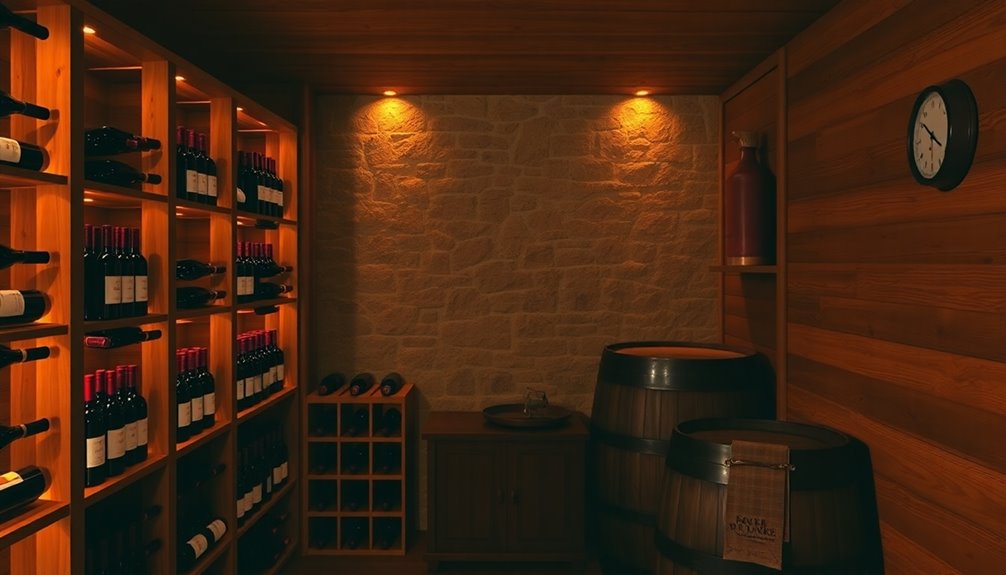
To keep your wine at its best, store it away from sunlight.
UV rays can damage the wine and alter its flavor, even if it's in a colored bottle.
For ideal preservation, aim for completely dark conditions to shield your bottles from any light exposure.
UV Damage Prevention
How can you guarantee your wine stays at its best? To prevent UV damage and secure ideal wine preservation, you need to keep your bottles away from light.
Here are some tips to achieve dark storage conditions:
- Use wine cellars or fridges designed for dark environments.
- Choose areas with minimal light exposure, avoiding windows and bright rooms.
- Opt for incandescent bulbs when lighting your storage space, as they emit minimal UV radiation.
- Store your wine in colored glass bottles for added protection against harmful UV exposure.
Additionally, mindful art of decluttering can help you create a dedicated space for your wine storage, ensuring it remains undisturbed and protected from light.
Bottle Color Importance
When it comes to preserving your wine, the color of the bottle plays an essential role. Colored glass bottles provide protection against harmful UV exposure, which can cause light damage and degrade your wine's quality. Storing wine in dark storage conditions helps maintain its flavor and aroma integrity over time. Additionally, just like how chia seeds offer nutritional benefits when included in diets, the right bottle color can enhance the longevity of your wine.
Here's a quick breakdown of bottle color importance:
| Bottle Color | UV Protection Level | Common Types |
|---|---|---|
| Dark Green | High | Bordeaux, Chianti |
| Brown | Very High | Port, Stout |
| Clear | Low | Sparkling, White |
| Blue | Moderate | Riesling, Dessert |
| Amber | High | Some IPA, Belgian |
Opt for dark bottles and keep your wine away from sunlight for the best results!
Optimal Storage Conditions
Storing wine in ideal conditions means keeping it away from sunlight and harmful UV rays. Exposure to light can degrade your wines and lead to unpleasant flavors.
Here are some tips for best storage conditions:
- Choose dark spaces: Long-term wine preservation is best achieved in complete darkness.
- Use colored bottles: While they offer some protection, they shouldn't be your only defense.
- Opt for incandescent bulbs: They emit fewer harmful UV rays compared to fluorescent ones.
- Avoid windows: Keep your wines away from direct light sources to maintain their integrity.
Be Mindful of Humidity

While you might focus on temperature when storing your beverages, humidity plays a crucial role in preserving their quality. The ideal storage humidity for wine is around 70%, which prevents corks from drying out and exposing wine to air. For most beverages, aim for a humidity range of 50% to 80%.
| Humidity Level | Effect on Beverages |
|---|---|
| Below 50% | Corks shrink, spoilage risk |
| 50% – 80% | Best for storage |
| Above 80% | Mold growth, label damage |
| Excess moisture | Cork issues, spoilage risk |
| Consistent levels | Quality and longevity boost |
To maintain humidity, use a pan of water or a dehumidifier. This balance is key to keeping your beverages in perfect condition!
Sideways Bottles Prevent Cork Issues
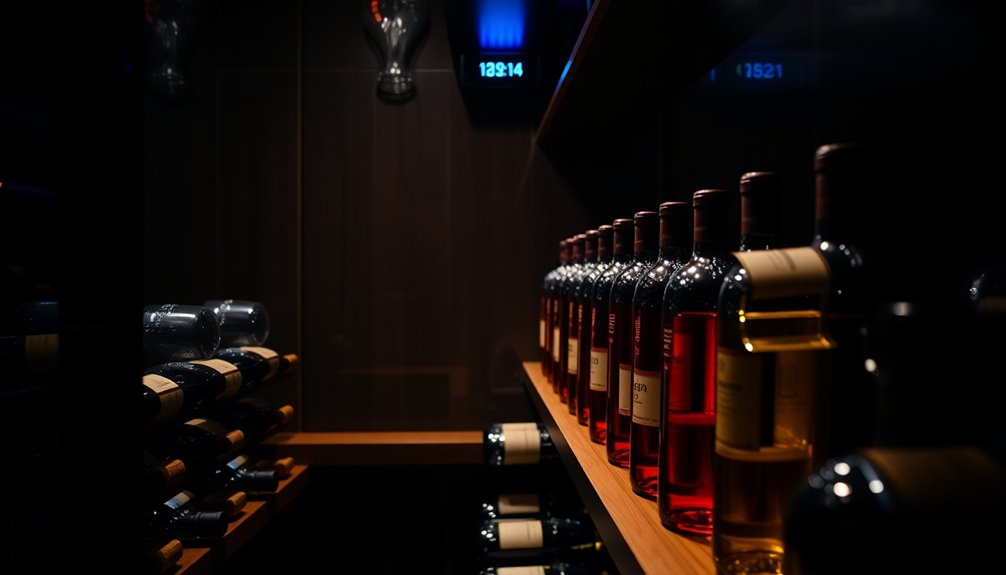
- Keeps the Cork Moist: Continuous contact with the wine helps keep the cork from drying out.
- Prevents Seepage: A well-hydrated cork minimizes the risk of leaks and spoilage.
- Space Efficient: Horizontal racking allows for better organization and maximizes storage space.
- Ideal for Older Wines: Long-term aging benefits most from this traditional storage method.
Additionally, proper storage methods can also enhance cognitive growth through the enjoyment of wine-tasting experiences and social interactions.
With bottles stored properly, you confirm the quality of your favorite wines remains intact!
Watch for Major Vibrations

Maintaining your wine's quality goes beyond cork management; it also involves minimizing exposure to vibrations. Significant vibrations can accelerate chemical reactions that harm wine quality over time, especially in long-term storage.
While subtle vibrations from household appliances mightn't affect short-term collections, you should seek stable locations free from major vibrations for your prized bottles. Excessive movement can disturb sediment in older wines, leading to a gritty texture when poured.
To preserve the integrity and flavor profile of your wine, treat bottles gently and store them in undisturbed environments. Prioritizing vibration-free conditions guarantees that your wine remains as delightful as intended, allowing you to enjoy it for years to come.
Frequently Asked Questions
What Is the Best Temperature to Store Beverages?
The best temperature for storing beverages varies by type. For general drinks, keep 'em between 32°F to 40°F to preserve flavor and carbonation.
Red wines thrive at 50°-60°F, while whites prefer 45°-50°F.
Beer styles differ too; store heavier ales at 45°-55°F and lighter lagers at 38°-45°F.
Soft drinks are happiest at 40°-60°F, and spirits can sit comfortably at 40°-60°F.
Consistency is key, so monitor the temperature regularly!
What Temperature Should a Beverage Cooler Be At?
Did you know that storing beverages at the wrong temperature can reduce their flavor by up to 30%?
For your beverage cooler, aim for a range of 32°F to 45°F (0°C to 7°C) for soft drinks, beer, and white wines.
If you have red wines, set it between 50°F to 60°F (10°C to 15°C).
Keeping these temperatures consistent will enhance taste and freshness, ensuring each sip is enjoyable.
What Temperature Should Soft Drinks Be Stored At?
To keep your soft drinks tasting their best, store 'em at a temperature between 40°F and 60°F.
For that extra invigorating kick, aim for around 37°F.
If they're exposed to higher temperatures, you'll notice a dip in flavor and quality.
Place your drinks on the middle shelves of your fridge where it's most stable, and avoid overcrowding to guarantee proper air circulation for ideal cooling.
Enjoy your perfectly chilled beverages!
What Is the Best Temperature for Long Term Wine Storage?
For long-term wine storage, you'll want to keep it around 55°F (13°C). This temperature preserves the wine's flavor and aroma without speeding up aging.
Avoid letting it drop below 25°F (-4°C) to prevent freezing, which can damage the wine. Also, try not to exceed 68°F (20°C), as heat can ruin the wine's profile.
Consistency is key—using a wine fridge can help maintain the ideal environment for your collection.
Conclusion
By following these seven tips, you'll guarantee your beverages stay in prime condition, just like a vintage car in a climate-controlled garage. Remember, proper temperature and storage can elevate your drink experience, whether it's a fine wine or a craft brew. So, keep those bottles away from sunlight, avoid the fridge for long-term storage, and store them sideways to prevent cork damage. With a little care, you'll always enjoy your drinks at their best!
Cindy thoroughly researches juicing trends, techniques, and recipes to provide readers with practical advice and inspiration. Her writing style is accessible, engaging, and designed to make complex concepts easy to understand. Cindy’s dedication to promoting the advantages of juicing shines through her work, empowering readers to make positive changes in their lives through the simple act of juicing.

